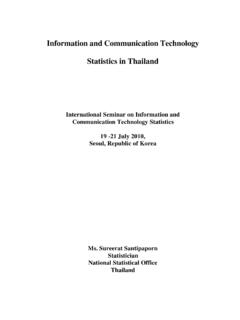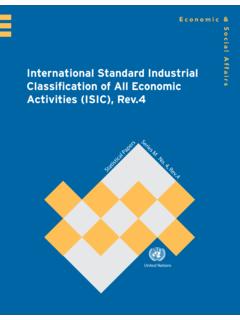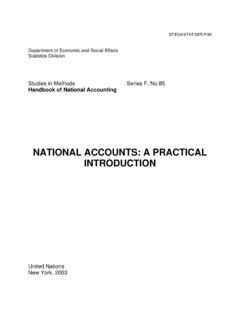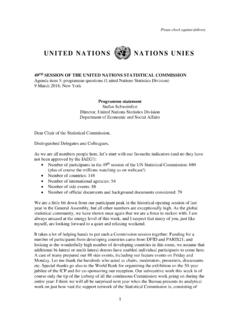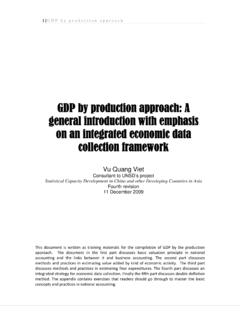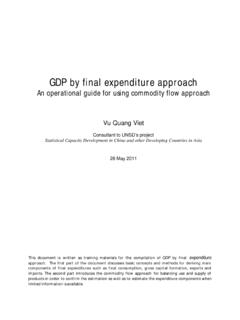Transcription of GOVERNMENT / PUBLIC SECTOR / PRIVATE SECTOR …
1 Fourth meeting of the Advisory Expert Group on National Accounts 30 January 8 February 2006, Frankfurt Issue 36 PRIVATE / PUBLIC / GOVERNMENT sectors delineation (sectorization boundaries) GOVERNMENT / PUBLIC SECTOR / PRIVATE SECTOR DELINEATION ISSUES by Task Force on Harmonisation of PUBLIC SECTOR Accounting TASK FORCE ON HARMONISATION OF PUBLIC SECTOR ACCOUNTING GOVERNMENT / PUBLIC SECTOR / PRIVATE SECTOR DELINEATION ISSUES (AEG 36) November 2005 Amended version following October 2005 meeting of TFHPSA and reflecting outcome of July 2005 AEG meeting 2 TABLE OF CONTENTS Executive A Introduction .. 4 B The PUBLIC SECTOR .. 4 C General GOVERNMENT SECTOR Economically Significant Prices.
2 5 D Conclusion and Recommendations .. 5 I 11 II The present Sectors .. 11 A The PUBLIC SECTOR .. 12 B The General GOVERNMENT 12 C The Corporations SECTOR .. 12 Institutional Units In The PUBLIC 12 A GOVERNMENT units .. 13 B Corporations .. 14 C Nonprofit institutions .. 15 III Identification of PUBLIC SECTOR Units: the notion of A Definition of an institutional unit .. 16 B Definition of 16 C NPIs controlled and mainly financed by GOVERNMENT versus NPIs serving households that obtain all or most of their funds from GOVERNMENT .. 24 IV Identification of market producers: Economically Significant A Current definition and difficulties.
3 24 B 25 V Other relevant cases of sectoral delineation not covered in this 3 Acronyms GBE GOVERNMENT business enterprise GFSM 2001 GOVERNMENT Finance Statistics Manual 2001 ESA 95 European System of Accounts 1995 IFAC International Federation of Accountants IPSAS International PUBLIC SECTOR Accounting Standards IPSASB International PUBLIC SECTOR Accounting Standards Board (IFAC) formerly the PSC NPI Nonprofit institution PPP PUBLIC PRIVATE partnership PSC PUBLIC SECTOR Committee (IFAC) now the IPSASB SNA System of National Accounts 1993 SPV Special purpose vehicle TFHPSA Task Force on Harmonisation of PUBLIC SECTOR Accounting WGII Working Group II (for SNA review ), TFHPSA Note: In the course of preparing this revision, there was extensive correspondence concerning the treatment of NPIs to be included within general GOVERNMENT considering the position of those concerned with the preparation and implementation of the handbook on non-profit institutions.
4 Their contribution to the discussion surrounding the update of the SNA is gratefully acknowledged. 4 Executive Summary A Introduction This paper proposes the addition of material to the SNA to clarify the current definitions of the boundaries of general GOVERNMENT and the wider PUBLIC SECTOR . The changes are needed for two main reasons: First, governments organize their business in more complicated ways and extra guidance is needed to make a clear distinction between GOVERNMENT and PUBLIC corporations and the rest of the economy Second, two phrases in the current SNA have caused particular difficulty in their application. These are economically significant prices and controlled and mainly financed in relation to NPIs.
5 Many countries have developed their own customs and practices to supplement the limited material in SNA 93 to assist its application. The purpose of the additions is to improve the consistency of the application of SNA principles across countries. The new material tries to be as comprehensive and clear as possible. However the classification of units can be difficult when structures are complex. Thus although the new guidance will add clarity and consistency, judgment will still be needed in some cases. The material presented here is focused on the boundaries of the GOVERNMENT and PUBLIC sectors. This is part of the more general rules on sectorisation across the whole economy and may have some wider applicability.
6 However they are set out in detail here because use of GOVERNMENT and PUBLIC SECTOR data for administrative and policy purposes makes clarity especially important. The proposals follow investigations undertaken by the TFHPSA. This involved the collection of current country practices, together with material from accounting standards. A special workshop was held to agree on the material and develop improved guidance on economically significant prices. There are two main boundaries to be considered: First the boundary between the PUBLIC and PRIVATE sectors Second the boundary between the market and non-market sectors in the PUBLIC SECTOR . Then: General GOVERNMENT is the group of PUBLIC SECTOR non-market entities PUBLIC corporations are PUBLIC SECTOR market entities.
7 This can be split between financial and non-financial corporations The resulting recommendations promote consistency across the world for national accounts and harmonization between economic and financial accounting reporting. B The PUBLIC SECTOR - Control The PUBLIC SECTOR is defined in the SNA (Chapter 19) as the national, regional, and local governments plus institutional units controlled by GOVERNMENT units. Problems arise in relation to identification of the latter units and further clarification is recommended. 5A GOVERNMENT controlled entity might be an entity that can be a source of financial gain to the GOVERNMENT that controls it because it produces goods and services and sells them at market prices (referred to as corporations in the SNA) or it might be an entity that cannot be a source of financial gain to the GOVERNMENT regardless of the prices for which it sells the goods and services it produces (nonprofit institutions).
8 Governments exert control over these two types of entities differently. Control of corporations In the SNA, a GOVERNMENT controls a corporation if it has the ability to determine the general corporate policy. In the International PUBLIC SECTOR Accounting Standards (IPSASs) issued by the International Federation of Accountants International PUBLIC SECTOR Accounting Standards Board, a GOVERNMENT controls a corporation if it has the power to govern its financial and operating policies so as to benefit from its activities. It is recommended that the definition of control in the SNA [SNA ] be further elaborated along the lines of the definition in the IPSASs and practices currently used by countries.
9 The difference in the definitions is relevant to corporations for which the GOVERNMENT involvement is as a fiduciary or trustee, such as for autonomous pension funds for GOVERNMENT The classification of such units in the SNA is not entirely clear and the proposed change to the SNA definition of control will result in the classification of these particular units to the PRIVATE SECTOR . Control of nonprofit institutions More clarification on which non-market nonprofit institutions are part of the PUBLIC SECTOR in economic accounting could be provided. For non-market NPIs, the current requirement to be mainly financed by GOVERNMENT should be included in a list of indicators of control.
10 C General GOVERNMENT SECTOR Economically Significant Prices Once the coverage of the PUBLIC SECTOR is clearly defined, there is a need to classify PUBLIC SECTOR entities as either engaging in market or non-market production, , as being in the PUBLIC corporations SECTOR or general GOVERNMENT SECTOR respectively. In the SNA, an institutional unit is a market producer if it charges economically significant prices for all or most of its output. The definition of an economically significant price is, however, quite general and further guidance is recommended. D Conclusion and Recommendations It is recommended that the SNA definition of control be extended to align more closely with the financial accounting definition of control in the IPSASs and current practices.
